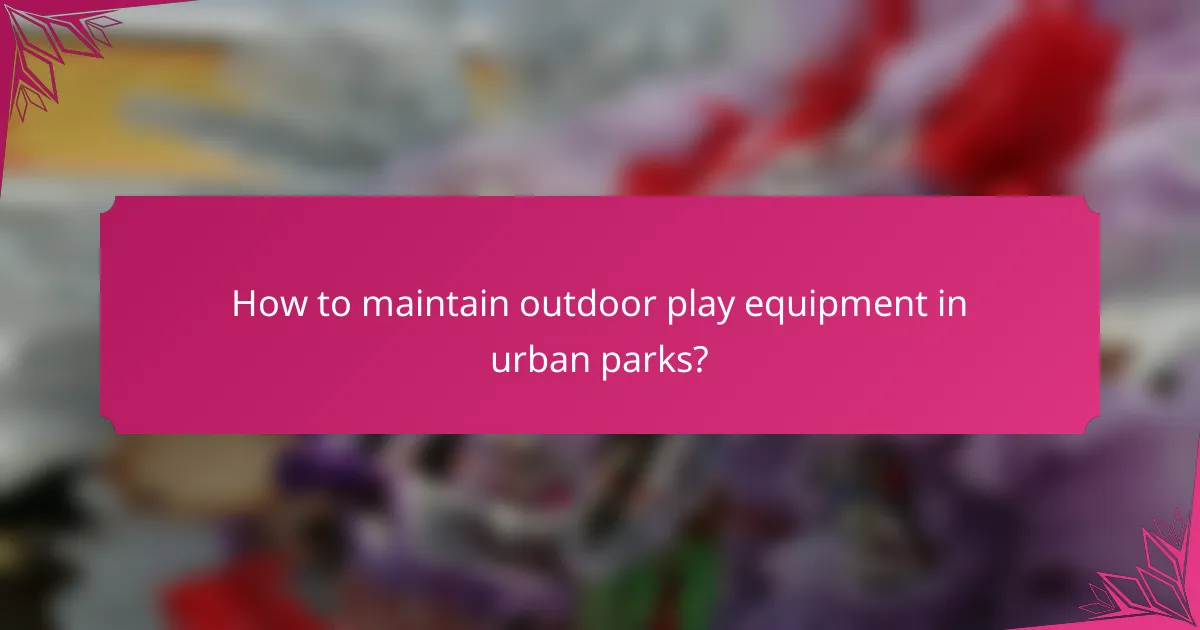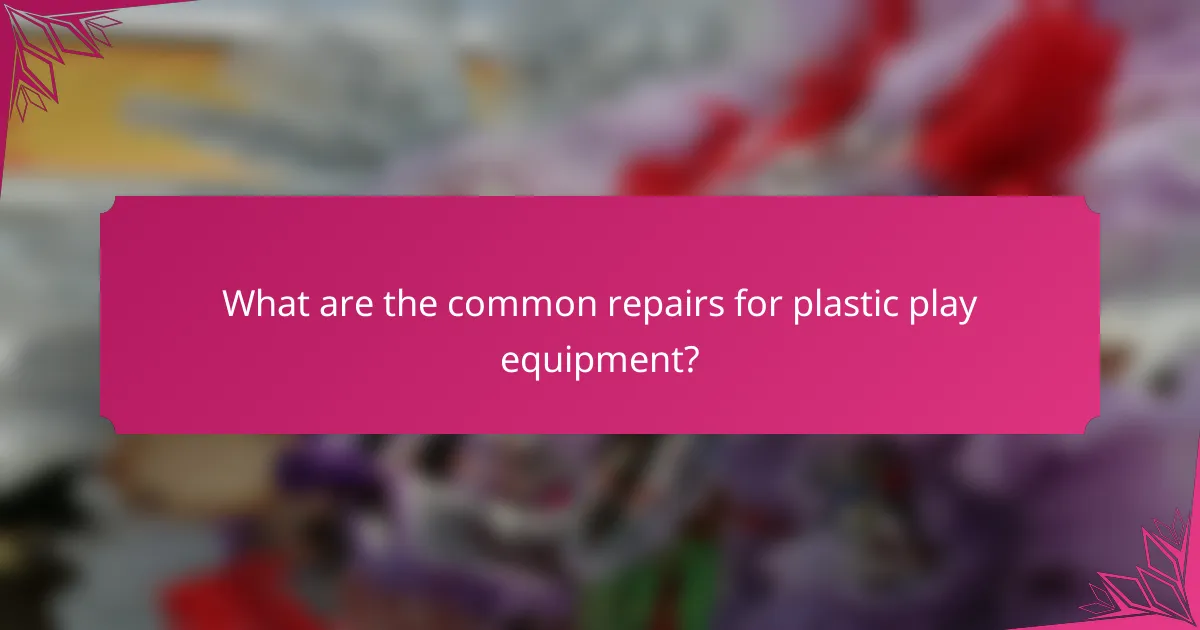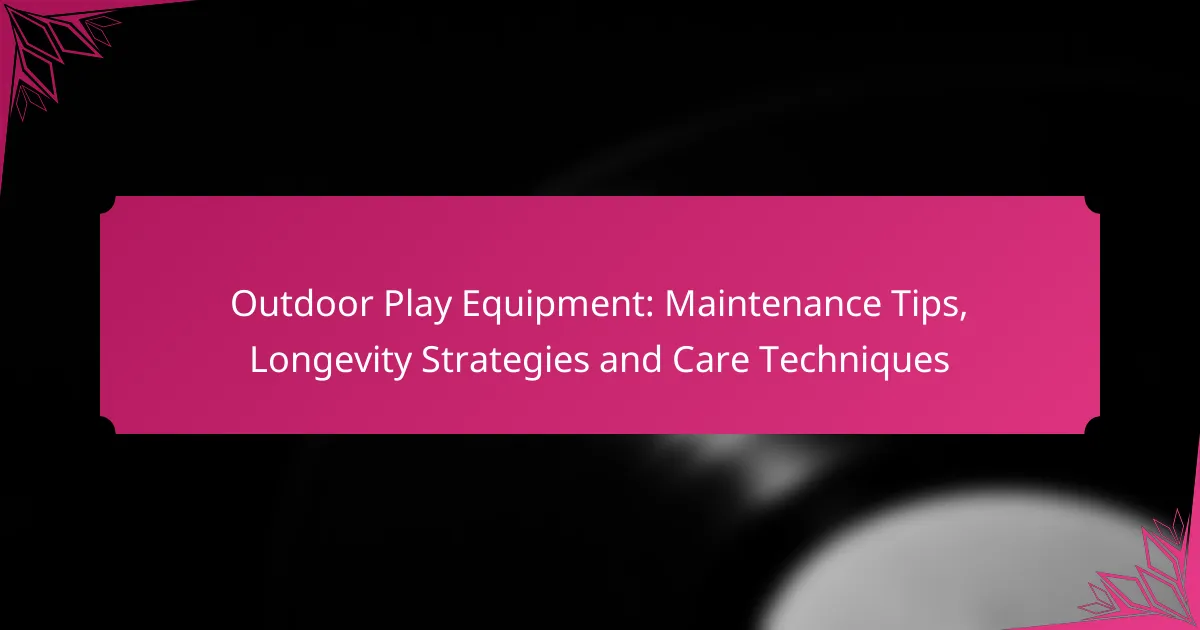Proper maintenance of outdoor play equipment is crucial for ensuring safety and extending its lifespan. By implementing regular care routines and selecting durable materials, you can significantly reduce the risk of accidents and costly repairs. This guide will provide essential tips and techniques for maintaining various types of play structures, ensuring they remain safe and enjoyable for children.

How to maintain outdoor play equipment in urban parks?
Maintaining outdoor play equipment in urban parks is essential for safety and longevity. Regular care ensures that the equipment remains functional and safe for children, reducing the risk of accidents and costly repairs.
Regular inspections for wear and tear
Conducting regular inspections is crucial to identify any signs of wear and tear on outdoor play equipment. Check for loose bolts, rust, cracks, or any other damage that could compromise safety.
Schedule inspections at least once a month, or more frequently if the equipment sees heavy use. Keeping a checklist can help ensure that no areas are overlooked during inspections.
Cleaning with non-toxic solutions
Cleaning outdoor play equipment with non-toxic solutions is important for the health of children and the environment. Use mild soap and water or vinegar-based cleaners to remove dirt, grime, and potential contaminants.
Avoid harsh chemicals that could harm the equipment or pose health risks. Regular cleaning helps maintain the appearance of the equipment and can prevent the buildup of harmful substances.
Lubricating moving parts
Lubricating moving parts of play equipment is essential for smooth operation and to prevent wear. Use a silicone-based lubricant for swings, slides, and other moving components to reduce friction.
Perform lubrication every few months, or more often if the equipment is used heavily. This simple maintenance step can extend the life of the equipment and enhance user experience.
Checking safety features
Regularly checking safety features on outdoor play equipment ensures that they function correctly and meet safety standards. Inspect safety barriers, soft landing surfaces, and any other protective elements.
Make sure that all safety features are intact and compliant with local regulations. Address any issues immediately to maintain a safe play environment for children.

What are the best longevity strategies for backyard playgrounds?
To ensure the longevity of backyard playgrounds, focus on selecting durable materials, applying protective coatings, and managing drainage effectively. These strategies help prevent wear and tear, extend the life of the equipment, and maintain safety for users.
Choosing weather-resistant materials
Selecting weather-resistant materials is crucial for the durability of playground equipment. Look for options like high-density polyethylene (HDPE), treated wood, or metal with rust-resistant coatings. These materials can withstand various weather conditions, reducing the risk of deterioration.
When choosing materials, consider the local climate. For instance, areas with high humidity may require more resistant options to prevent mold, while regions with extreme temperatures may benefit from materials that can handle thermal expansion and contraction.
Applying protective coatings
Protective coatings can significantly enhance the lifespan of playground equipment. Applying a weatherproof sealant or paint can shield surfaces from moisture, UV rays, and physical wear. Regularly inspect and reapply these coatings as needed, typically every few years, to maintain their effectiveness.
For wooden structures, consider using a wood preservative that repels water and insects. For metal components, a rust-inhibiting paint can prevent corrosion, especially in coastal areas where salt exposure is a concern.
Implementing proper drainage
Effective drainage is essential to prevent water accumulation around playground equipment, which can lead to structural damage and safety hazards. Ensure that the playground is installed on a slight slope to facilitate water runoff, and consider using gravel or porous materials in the surrounding area to enhance drainage.
Regularly check for pooling water and adjust the landscape as needed. Installing drainage systems, such as French drains, can also help manage excess water, particularly in regions prone to heavy rainfall.

How to care for wooden play structures?
Caring for wooden play structures involves regular maintenance to ensure their longevity and safety. Key practices include sealing and staining the wood annually and inspecting for rot and insect damage.
Sealing and staining wood annually
Sealing and staining wooden play structures annually protects them from moisture, UV rays, and wear. Use a high-quality, water-repellent sealant designed for outdoor wood, applying it in dry conditions for optimal adhesion.
Choose a stain that matches your aesthetic preferences while providing adequate protection. Look for products that offer UV protection and are free from harmful chemicals, especially if children will be using the equipment.
As a general rule, reapply sealant or stain every 12 months, or more frequently in harsh climates. Always follow the manufacturer’s instructions for the best results.
Inspecting for rot and insects
Regular inspections for rot and insect infestations are crucial for maintaining the integrity of wooden play structures. Look for soft spots, discoloration, or unusual smells, which may indicate rot, and check for signs of insect activity, such as holes or sawdust.
Conduct these inspections at least twice a year, ideally in spring and fall. If you find any damage, address it immediately to prevent further deterioration. Consider using treated wood or natural insect repellents to mitigate future issues.
Document any findings and repairs to keep track of the structure’s condition over time. This proactive approach can help extend the life of your play equipment significantly.

What are the common repairs for plastic play equipment?
Common repairs for plastic play equipment typically involve addressing cracks and reinforcing weak joints to ensure safety and longevity. Regular maintenance can prevent more significant issues and extend the lifespan of the equipment.
Replacing cracked components
When plastic play equipment develops cracks, it’s crucial to replace the affected components promptly. Cracks can compromise safety and lead to further damage if not addressed. Inspect the equipment regularly for visible signs of wear, especially in high-use areas.
To replace cracked parts, identify the specific component that needs replacement, such as slides or climbing structures. Many manufacturers offer replacement parts that can be ordered directly, ensuring compatibility and safety standards are met. Follow the manufacturer’s guidelines for installation to maintain structural integrity.
Reinforcing weak joints
Weak joints in plastic play equipment can lead to instability and potential accidents. Reinforcing these joints is essential for maintaining the overall safety of the play structure. Regularly check joints for signs of loosening or wear, especially after heavy use or extreme weather conditions.
To reinforce weak joints, consider using additional fasteners or brackets designed for outdoor use. Ensure that any materials used are weather-resistant to prevent future deterioration. If necessary, consult with a professional for more extensive repairs to guarantee compliance with safety regulations.

How to ensure safety in community playgrounds?
Ensuring safety in community playgrounds involves implementing effective strategies to minimize risks and enhance user protection. Key measures include installing impact-absorbing surfaces and conducting regular safety audits to identify potential hazards.
Installing impact-absorbing surfaces
Impact-absorbing surfaces are crucial for reducing injuries from falls in playgrounds. Materials such as rubber mulch, poured-in-place rubber, and engineered wood fiber can effectively cushion falls and meet safety standards like ASTM F1292.
When selecting surfaces, consider factors like maintenance requirements, durability, and cost. For instance, rubber surfaces may require less upkeep compared to wood fiber, which can decompose over time. Aim for a depth of at least 12 inches for optimal protection under play equipment.
Regular safety audits
Conducting regular safety audits is essential for maintaining a safe playground environment. These audits should include inspections of equipment, surfaces, and surrounding areas to identify wear and tear, loose parts, or other hazards.
Establish a routine schedule for audits, ideally every few months, and after severe weather events. Use a checklist to ensure all aspects are covered, such as checking for rust on metal parts, ensuring proper spacing between equipment, and verifying that surfaces are intact and clean. Engage community members in these audits to promote awareness and collective responsibility for safety.

What tools are essential for outdoor play equipment maintenance?
Essential tools for outdoor play equipment maintenance include basic hand tools, cleaning supplies, and safety gear. These tools help ensure that the equipment remains safe and functional for children.
Basic Hand Tools
Basic hand tools such as wrenches, screwdrivers, and hammers are crucial for regular maintenance tasks. These tools allow you to tighten bolts, replace screws, and make minor repairs as needed. Having a complete set on hand can save time and prevent equipment deterioration.
Cleaning Supplies
Cleaning supplies like soap, water, and brushes are necessary for keeping outdoor play equipment free from dirt and debris. Regular cleaning helps prevent rust and wear, extending the lifespan of the equipment. Consider using non-toxic cleaners to ensure safety for children.
Safety Gear
Safety gear, including gloves and goggles, is important when performing maintenance tasks. Wearing gloves protects your hands from sharp edges and chemicals, while goggles shield your eyes from dust and debris. Always prioritize safety to prevent accidents during maintenance.
